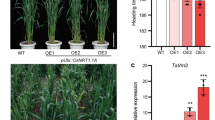Abstract
Tillering in rice (Oryza sativa L.) is an important agronomic trait that enhances grain production. A tiller is a specialized grain-bearing branch that is formed on a non-elongated basal internode that grows independently of the mother stem. Transgenic rice over-expressing the transcription factorOsTB1, a homologue of maizeTB1 (Teosinte Branched 1), exhibits markedly reduced lateral branching without the propagation of axillary buds being affected. However, the tillering mechanism remains unknown. Therefore, to further understand that mechanism, we applied proteomics methodology to isolate the proteins involved. Using two-dimensional gel electrophoresis and mass spectrometry, our analysis of the basal nodes from two rice cultivars that differ in their numbers of tillers showed that a rice serine proteinase inhibitor, OsSerpin, accumulates in great amounts in high-tillering ‘Hwachung’ rice. Northern blot analysis revealed that much moreOsSerpin transcript is found in ‘Hwachung’ than in relatively low-tillering ‘Hanmaeum’, likely because of high levels of transcription. Therefore, our data suggest that OsSerpin content determines the extent of lateral branching.
Similar content being viewed by others
Literature cited
Beveridge CA, Rnss JJ, Murfet IC (1994) Branching mulanlnm-2 inPisum saivum (grading studies and endogenous indole-3-acelic acid levels). Planl Physiol104: 953–919
Beveridge C, Weiler JL, Singer SR, Hofer MI (2003) Axillary merislem developmenl. Budding relationships between nelworks controlling flowering, branching, and photoperiod responsiveness. Plant Physiol131: 927–934
Booker J, Sieberer T, Wright W, Williamson L, Willett B, Stirnberg R, Turnbull C, Srinivasan M, Coddard P, Leyser O (2005) MAX1 encodes a cylochrome P450 family member that acls downstream of MAX3/4 to produce a carolenoid-derived branch-inhibiling hormone. Dev Cell8: 443–449
Bradford MM (1976) A rapid and sensitive method for the quanlilalion of microgram quantities of protein utilizing the principle of protein-dye binding. Anal Biochem72: 248–254
Clio K, Torres NL, Subbramanyam S, Deepak SA, Sardesai N, Han O, Williams CE, Ishii H, Iwahashi H, Rakwal R (2006) Protein extraclion/solubilization protocol for monocol and dicol planl gel-based proleomics. J Planl Biol49: 413–420
Christeller J, Laing W (2005) Planl serine proleinase inhibitors. Protein Pepl Lell12: 439–447
Doebley J, Stec A, Gustus C (1995) Teosinle branched 1 and Ihe origin of maize: Evidence for epislasis and the evolution of dominance. Genetics141: 333–346
Ishikawa S, Maekawa M, Arite T, Onishi K, Takamure I, Kyozuka J (2005) Suppression of liller bud activily in tillering dwarf mutants of rice. Plant Cell Physiol46: 79–86
Jiang H, Guo LB, Xue DW, Zeng DL, Zhang GH, Dong GJ, Gu MH, Qian Q (2006) Genetic analysis and gene-mapping of two reduced-culm-number mutants in rice. J Integr Plant Biol48: 341–347
Leyser O (2003) Regulation of shoot branching by auxin. Trends Plant Sci8: 541–545
Li X, Qian Q, Fu Z, Wang Y, Xiong G, Zeng D, Wang X, Liu X, Teng S, Hiroshi F, Yuan M, Luo D, Han B, Li J (2003) Control of tillering in rice. Nature422: 618–621
Lukens L, Doebley J (2001) Molecular evolution of the teosinte branched gene among maize and related grasses. Mol Biol Evol18: 627–638
Morris DA (1977) Transport of exogenous auxin in two branched dwarf pea seedlings (Pisum sativum L.). Planta136: 91–96
Napoli C (1996) The highly branched phenotype of thePetunia hybrida dad1-1 mutant is reversed by grafting. Plant Physiol111: 27–37
Napoli CA, Beveridge CA, Snowden KC (1999) Reevaluating concepts of apical dominance and the control of axillary branching. Curr Top Dev Biol44: 127–169
Shimizu-Salo S, Mori H (2001) Control of outgrowth and dormancy in axillary buds. Plant Physiol127: 1405–1413
Slirnberg P, van De Sande K, Leyser HMO (2002) MAX1 and MAX2 control shoot lateral branching inArabidopsis. Development129: 1131–1141
Takamure I (1994) Genetic studies on several mutants related to morphological and physiological characters in rice. Men Fac Agric Hokkaido Univ19: 151–202
Takamure I, Kinoshila T (1985) Inheritance and expression of reduced culm number character in rice. Jpn J Breed35: 17–24
Takeda T, Suwa Y, Suzuki M, Kilano H, Ueguchi-Tanaka M, Ashikari M, MaLsuoka M, Ueguchi C (2003) The OsTB1 gene negatively regulates lateral branching in rice. Plant J33: 513–520
Wang B, Ma M, Wu TL (2007) Aptamers improve the expression of a human granuIocyte-macrophage colony stimulating factor in transgenicArabidopsis thaliana seeds. J Plant Biol50: 29–37
Zou J, Chen Z, Zhang S, Zhang W, Jiang G, Zhao X, Zhai W, Pan X, Zhu L (2005) Characterizations and fine mapping of a mutant gene for high tillering and dwarfism in rice (Oryza sativa L.). Planta222: 604–612
Author information
Authors and Affiliations
Corresponding author
Rights and permissions
About this article
Cite this article
Yeu, S.Y., Park, B.S., Sang, W.G. et al. The serine proteinase inhibitor OsSerpin is a potent tillering regulator in rice. J. Plant Biol. 50, 600–604 (2007). https://doi.org/10.1007/BF03030715
Received:
Accepted:
Issue Date:
DOI: https://doi.org/10.1007/BF03030715




